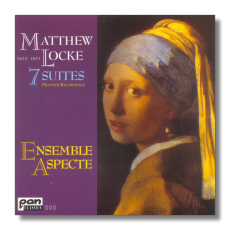
The Internet's Premier Classical Music Source
Related Links
- Latest Reviews
- More Reviews
-
By Composer
-
Collections
DVD & Blu-ray
Books
Concert Reviews
Articles/Interviews
Software
Audio
Search Amazon
Recommended Links
Site News
 CD Review
CD Review
Matthew Locke

Suites for Recorder
- Consorts of Two Parts
- Suite #2 in B Major
- Suite #6 in A minor/Major
- Suite #7 in C minor/Major
- The Broken Consort, Part II
- Suite #1 in C minor/Major
- Suite #2 in D minor/Major
- The Little Consort
- Suite #7 in G minor/Major
- Suite #8 in A minor
Ensemble Aspecte
 Matthias Weilenmann, recorder
Matthias Weilenmann, recorder
 Brian Franklin, viola da gamba
Brian Franklin, viola da gamba
 Martin Derungs, harpsichord and organ
Martin Derungs, harpsichord and organ
 Thorsten Bleich, arch-lute and theorbo
Thorsten Bleich, arch-lute and theorbo
Produced by Thomas Pfiffner
Pan Classics 510 068 DDD 73:45
Pan is a Zürich-based company with three labels to its name, Pan Classics being the one that we're interested in. This is the first of their releases that I have come across, and if their future recordings are as good as this, we're in for a treat. Performance, recorded sound, presentation are all first-rate, with an unexpected choice of music to boot.
Roger Harmon's notes open by quoting Roger North on Matthew Locke (1622-77): "Mathew Locke was the most considerable master of musick after Jenkins fell off […] until finally giving way to the devine Purcell." Locke was born in Devon and had his training as a chorister in Exeter Cathedral, from Edward Gibbons and William Wake. He seems to have gone abroad at the outset of the Civil War, when the Cathedral choir was disbanded – a manuscript annotation on a collection of Italian motets states that he was in "the Low Countreys" in 1648. By the early 1650s he was back in London. Charles II appointed "composer in ordinary" in 1660 and remained in the service of the royal court until his death, when he was succeeded by Henry Purcell.
Nine years before his appointment Locke had composed his Little Consort of Three Parts "made at the request of Mr. Wake [i.e., William] and his Schollars"; they were published by Playford in 1656. It is a collection of ten dance suites, built up of pavan, ayre (allemande), courante and sarabande, a format established by Lawes some three decades earlier, and extending the chamber-musical tradition fostered by composers like Jenkins and Coprario that would die out with Purcell. Harmon estimates that the Consort of Two Parts for several friends dates from shortly after the Little Consort; here Locke, perhaps under the influence of the fantasia-suites that occupied Jenkins in the latter part of his career, adds an opening fantasia and a dignified conclusion to the pattern of the suites in the earlier collection. And the Broken Consort Part II, dating from 1661, was one of the last effusions of English consort music ("broken" signifying a mixed ensemble of strings and wind).
Locke's approach is generally to simplify as he proceeds through the suite: the opening pavans and allemandes are often highly chromatic and densely polyphonic, giving way to simpler textures in the concluding courantes and sarabandes. Much of the music is very beautiful – in a quiet, shy kind of way. The Ensemble Aspecte – two parts Swiss, one part German and one part American – respond with real feeling to this delicate grace, giving performances as sympathetic as they are clean. Well worth investigating. And if you want to hear a very different approach to Locke's music, try Jordi Savall's Hespèrion XX in the Consort of Fower Parts (probably aslo composed in the 1650s) on Astrée Auvidis E8519: where the Ensemble Aspecte are bright and open with wide-eyed innocence, aided by the pearly playing of Matthias Weilenmann's recorder, Hespèrion XX – all on viols, with harp and organ continuo – are soft, sensuous, suggestive. The contrast is stark, and instructive: it underlines how much more there is to this music than any single performance can bring out.
Copyright © 1996/1998, Martin Anderson


















